


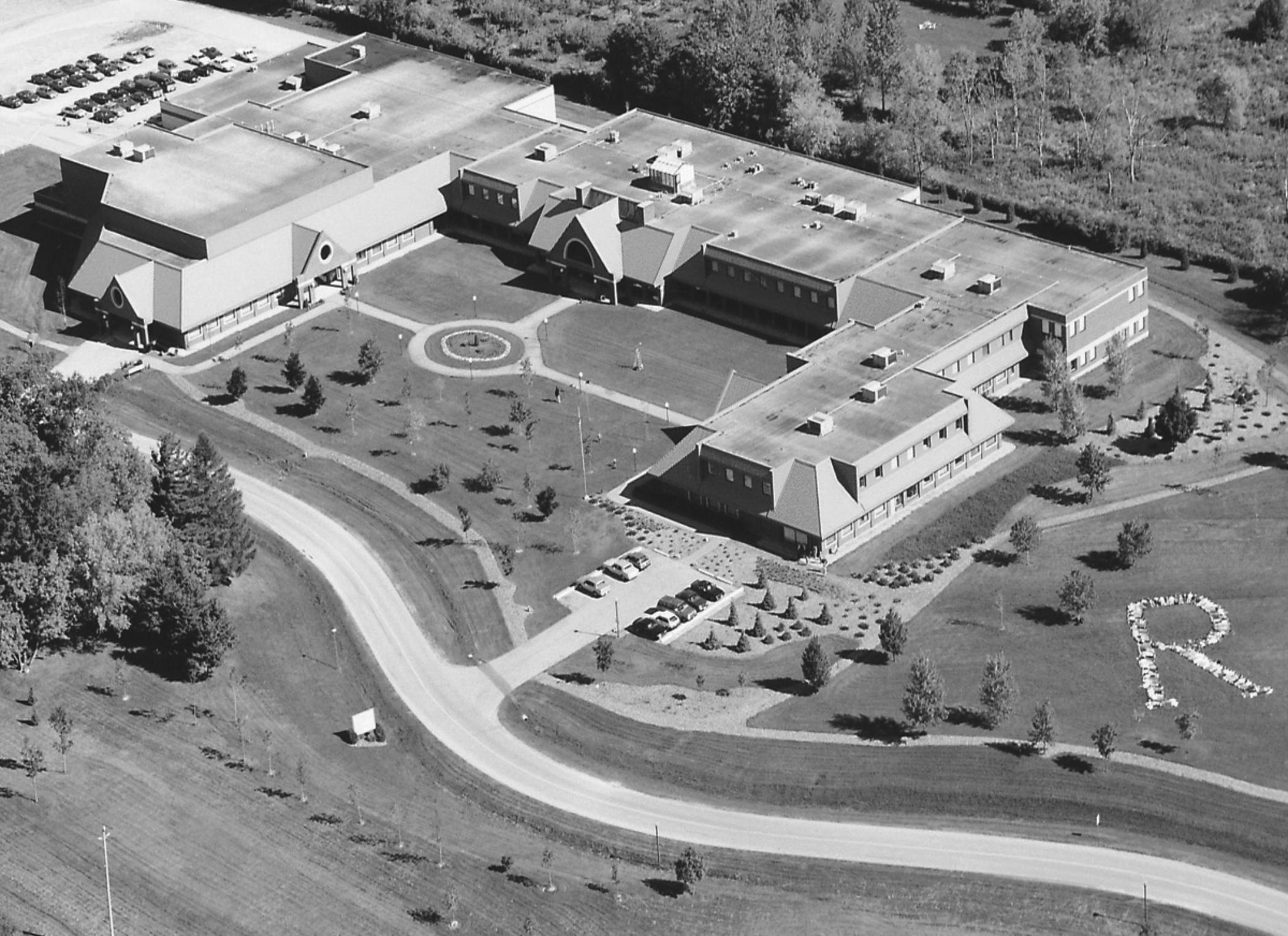
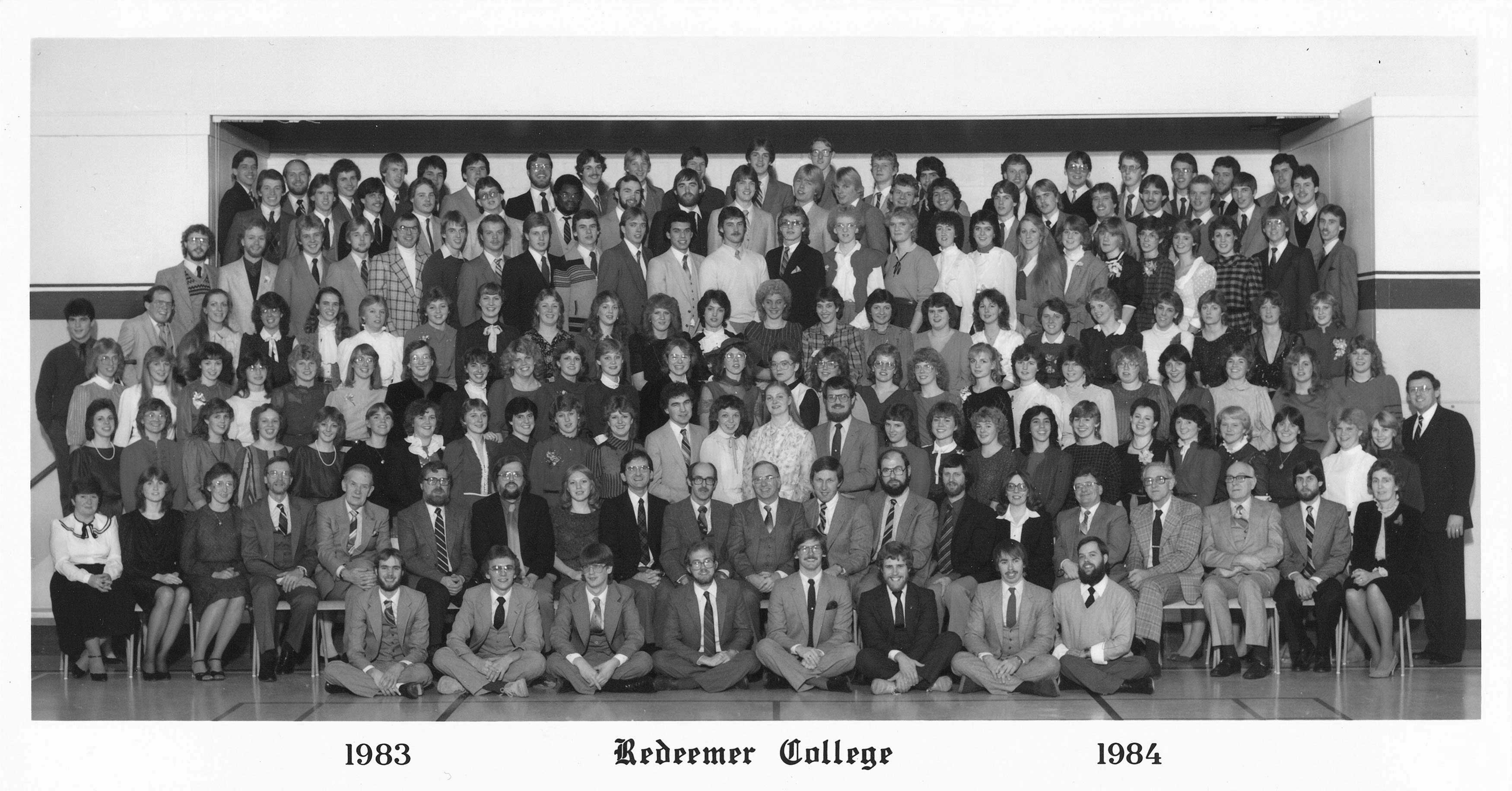
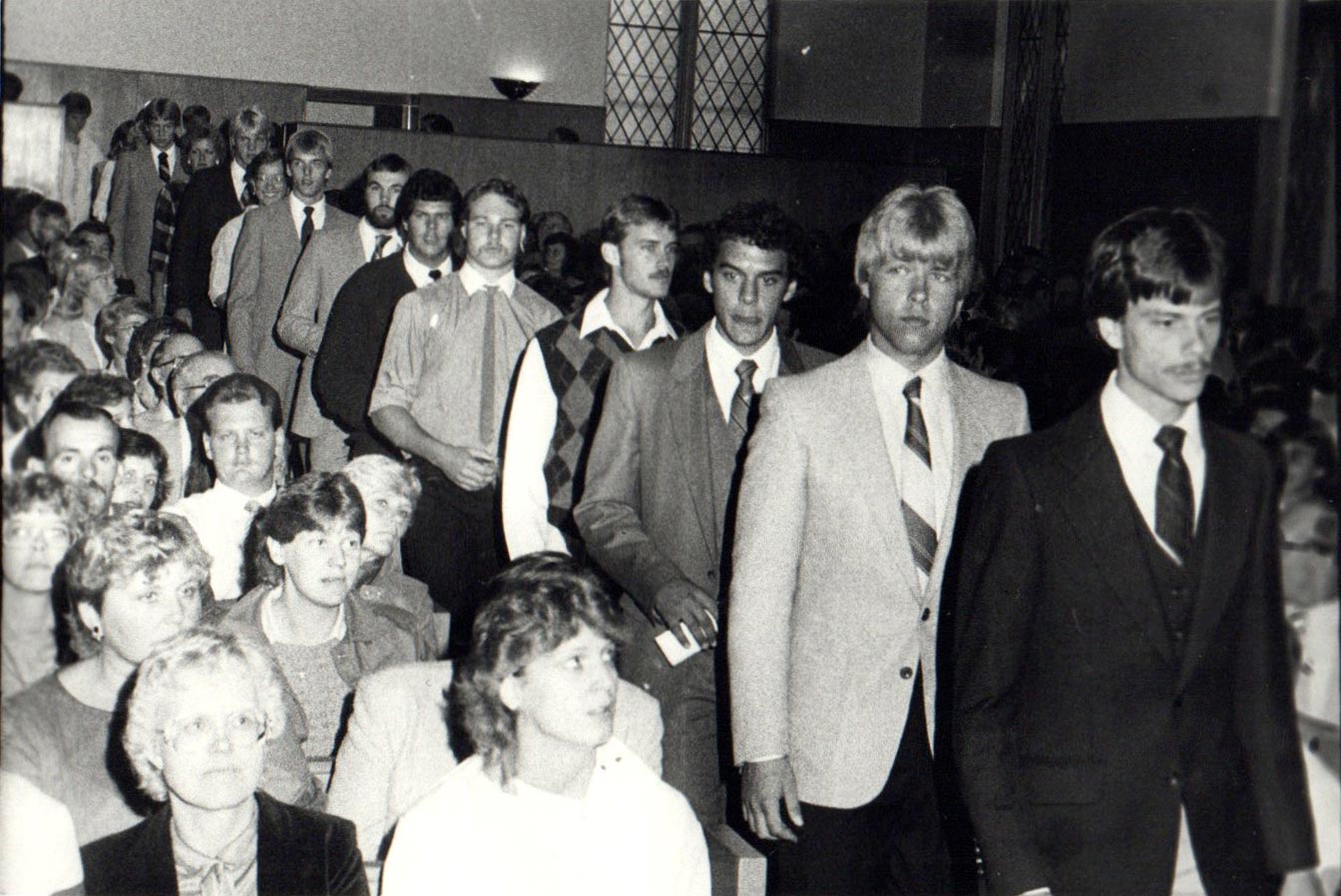
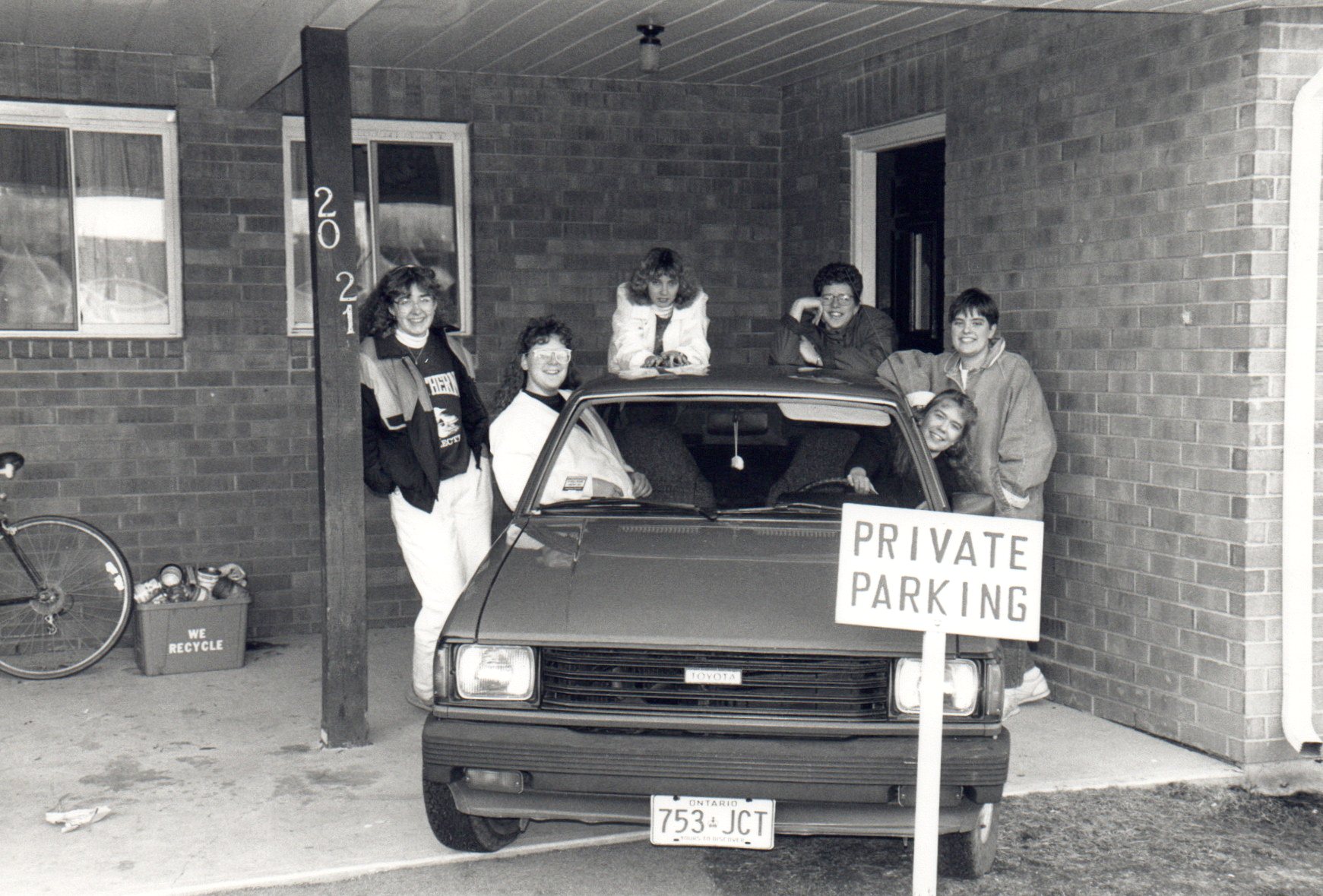
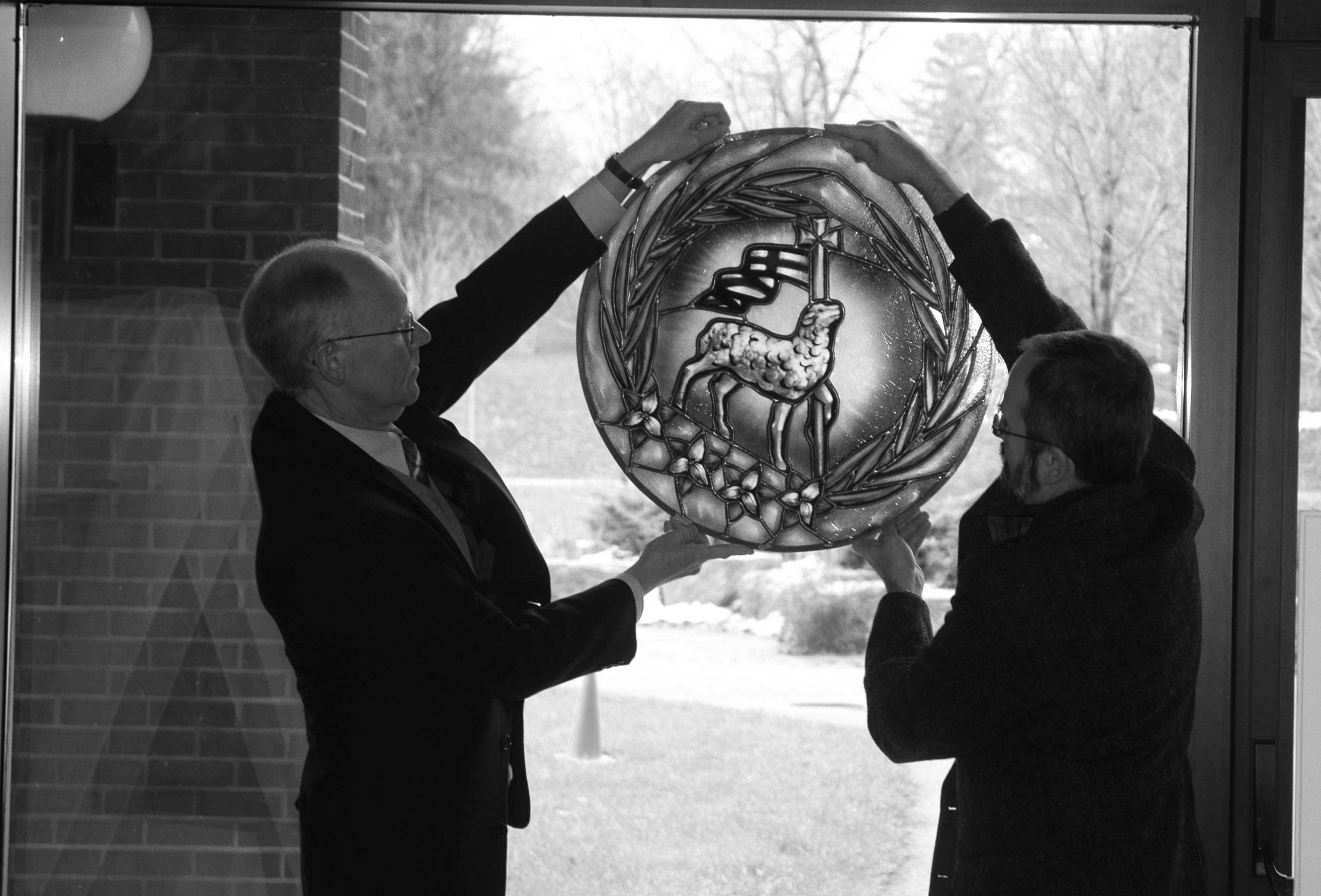
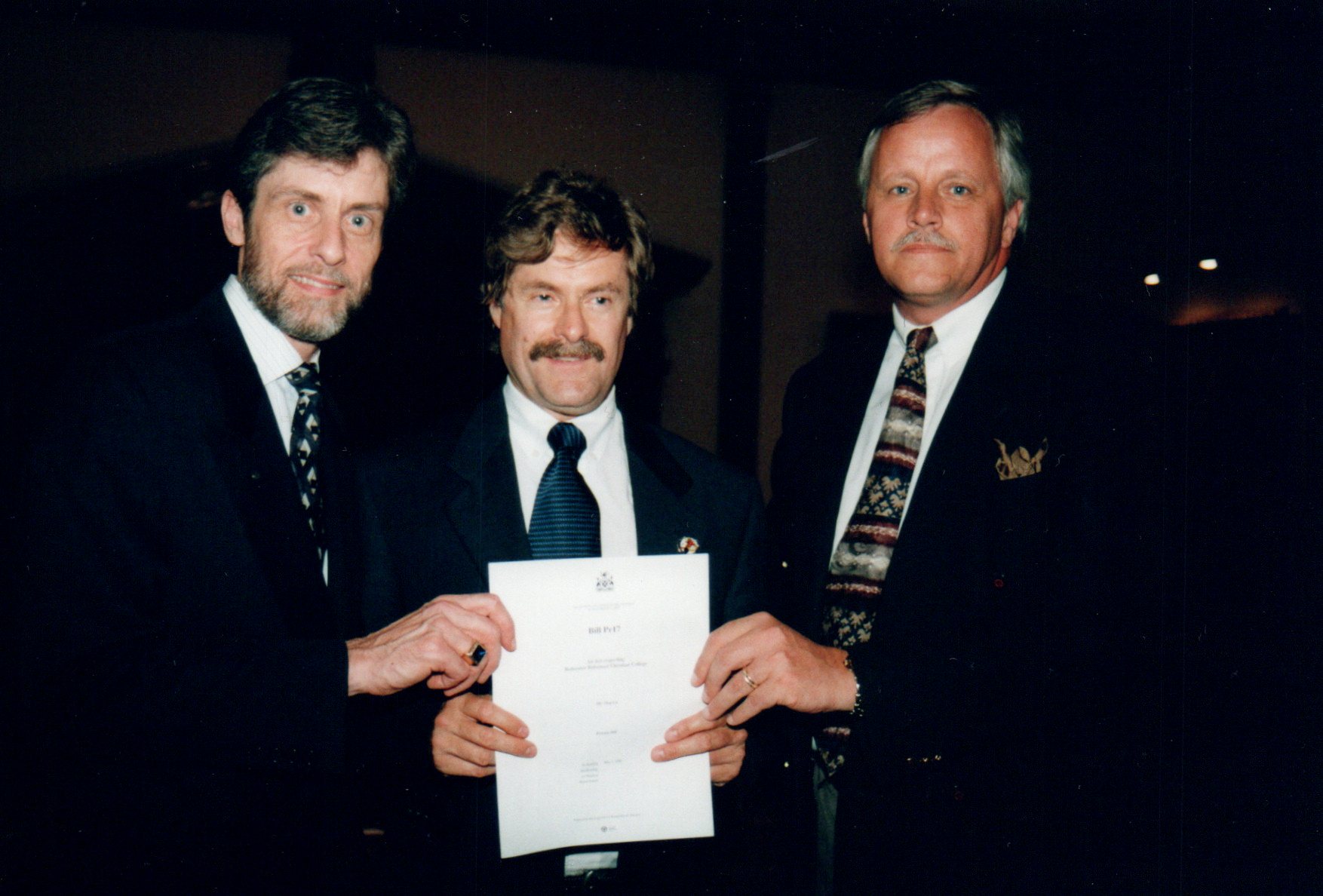
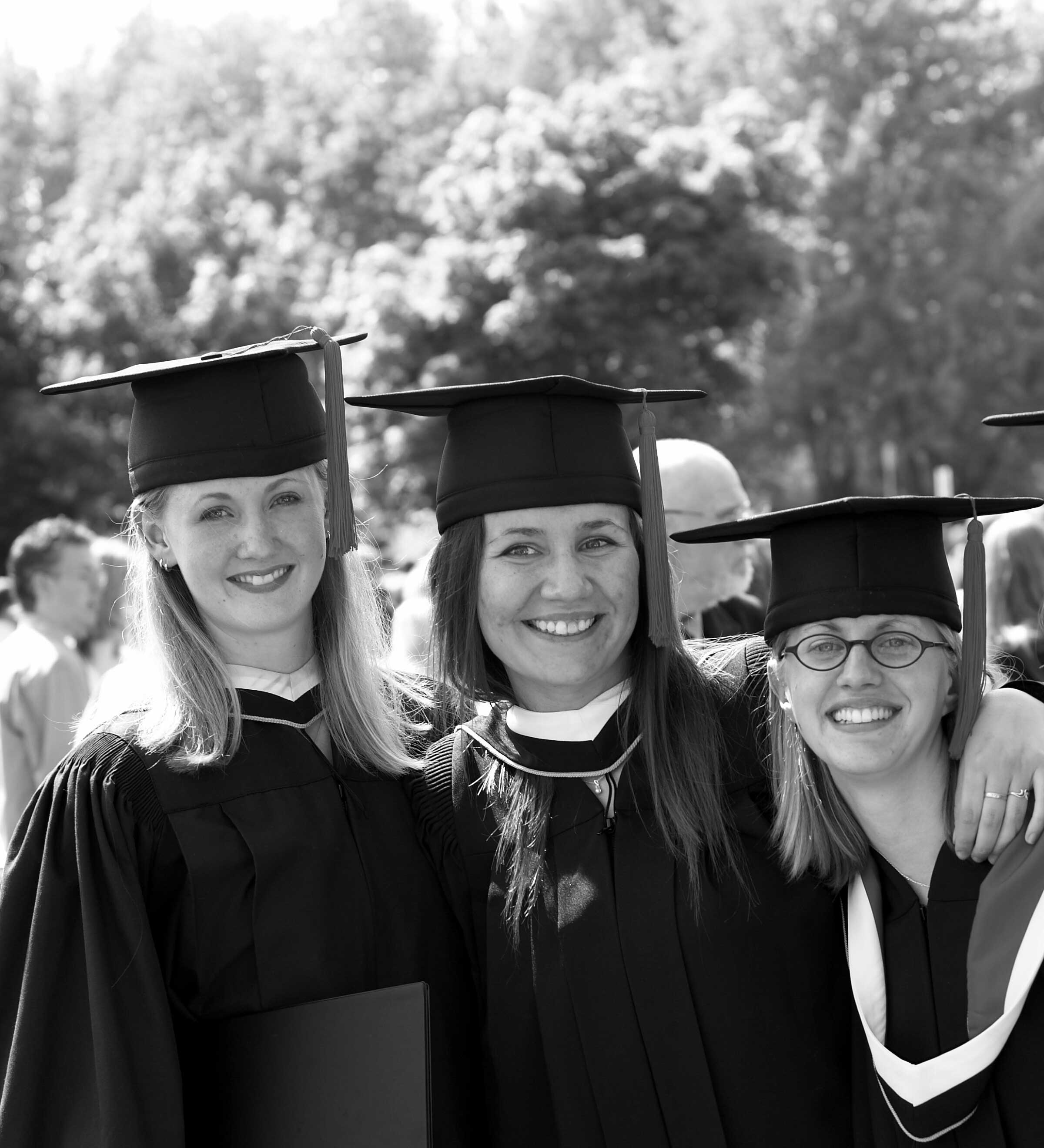
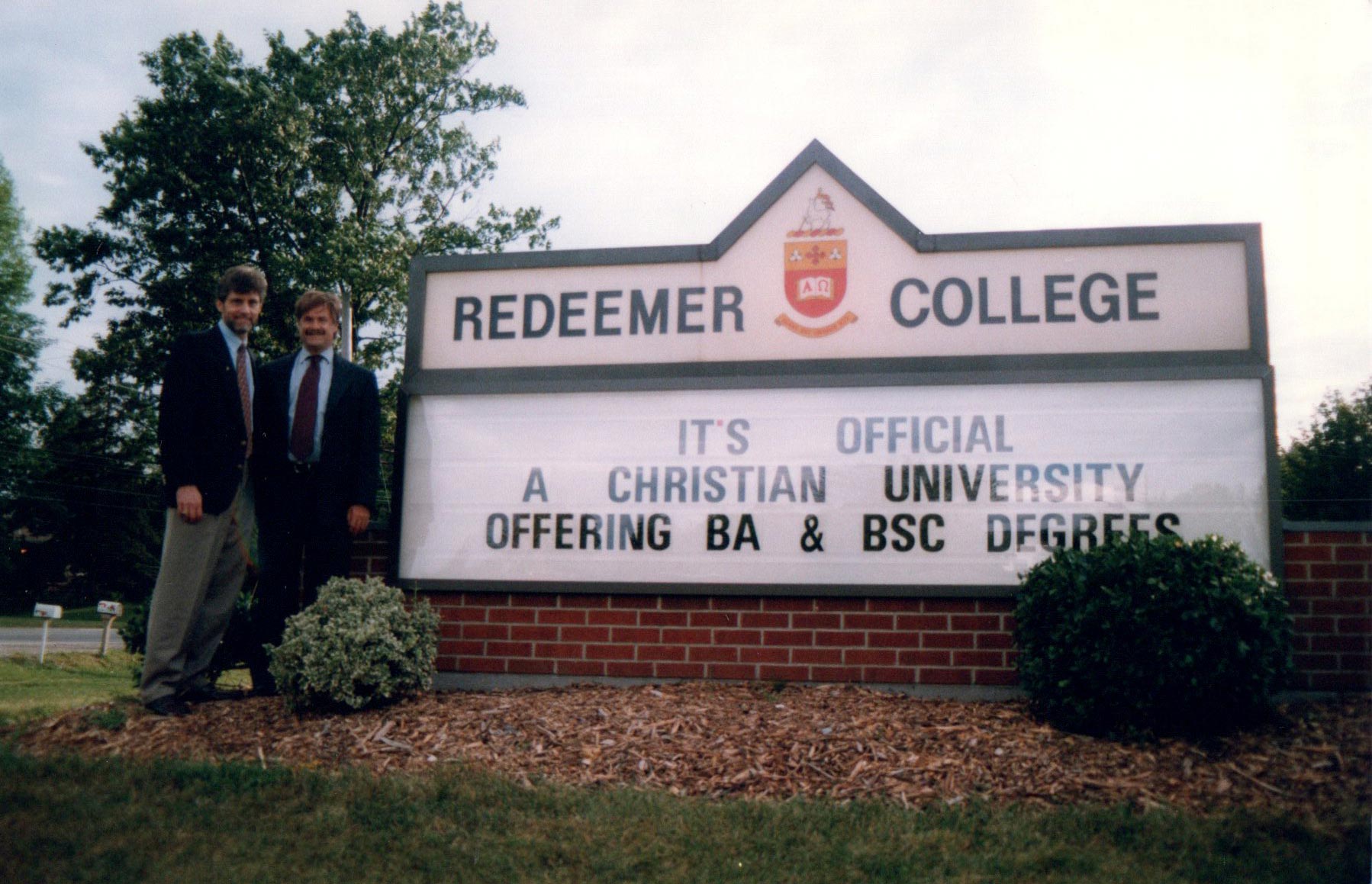
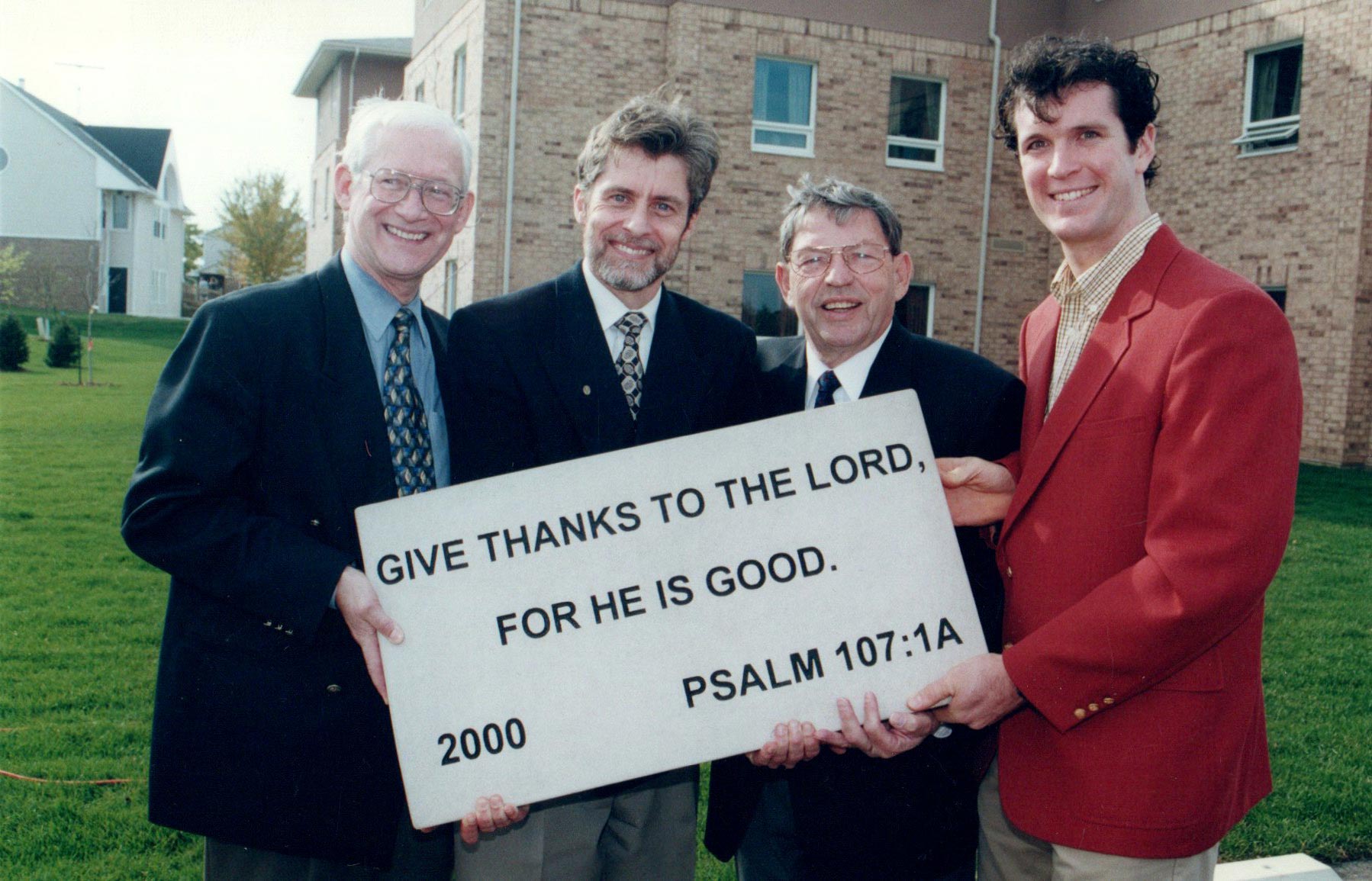
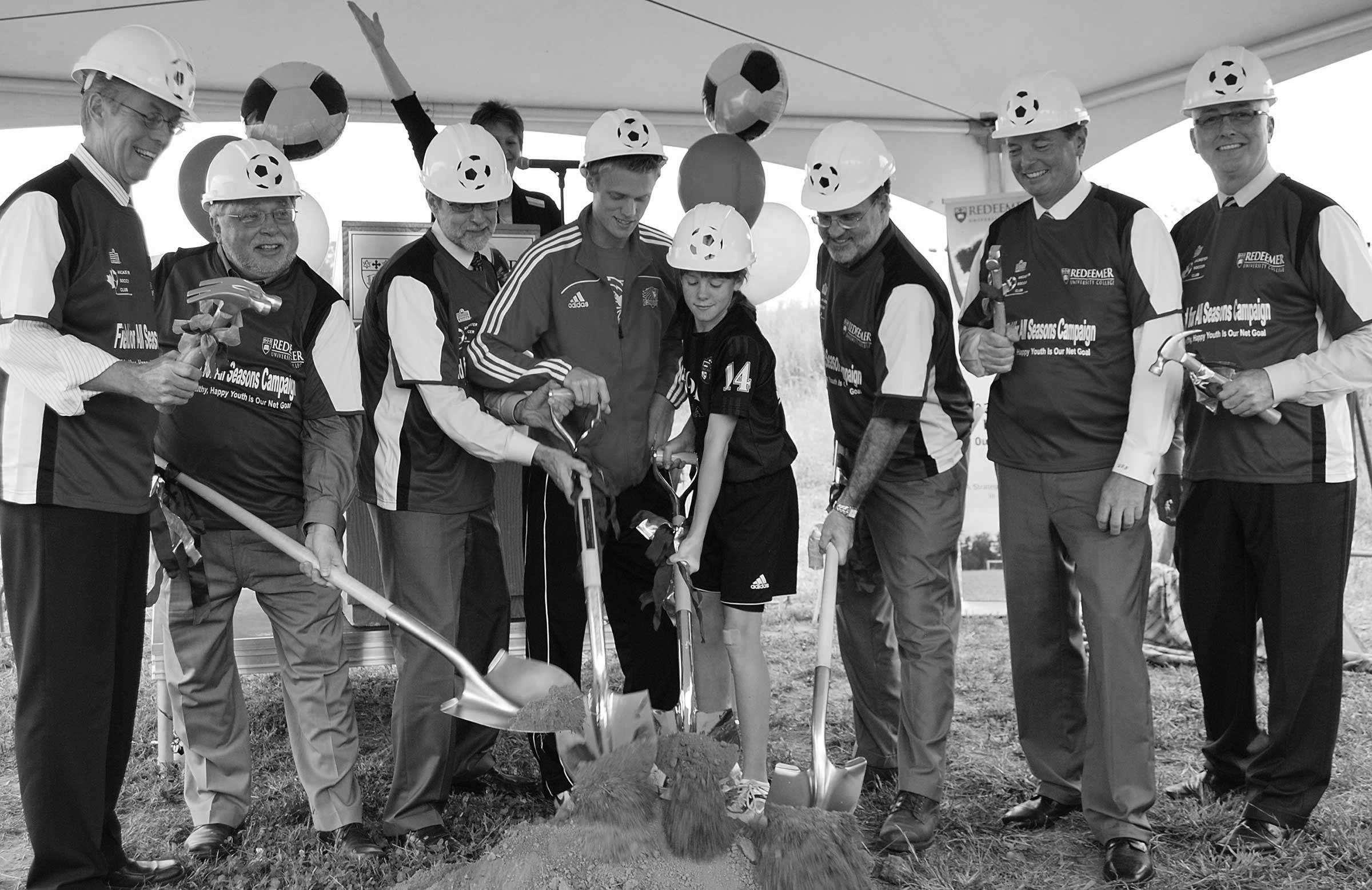
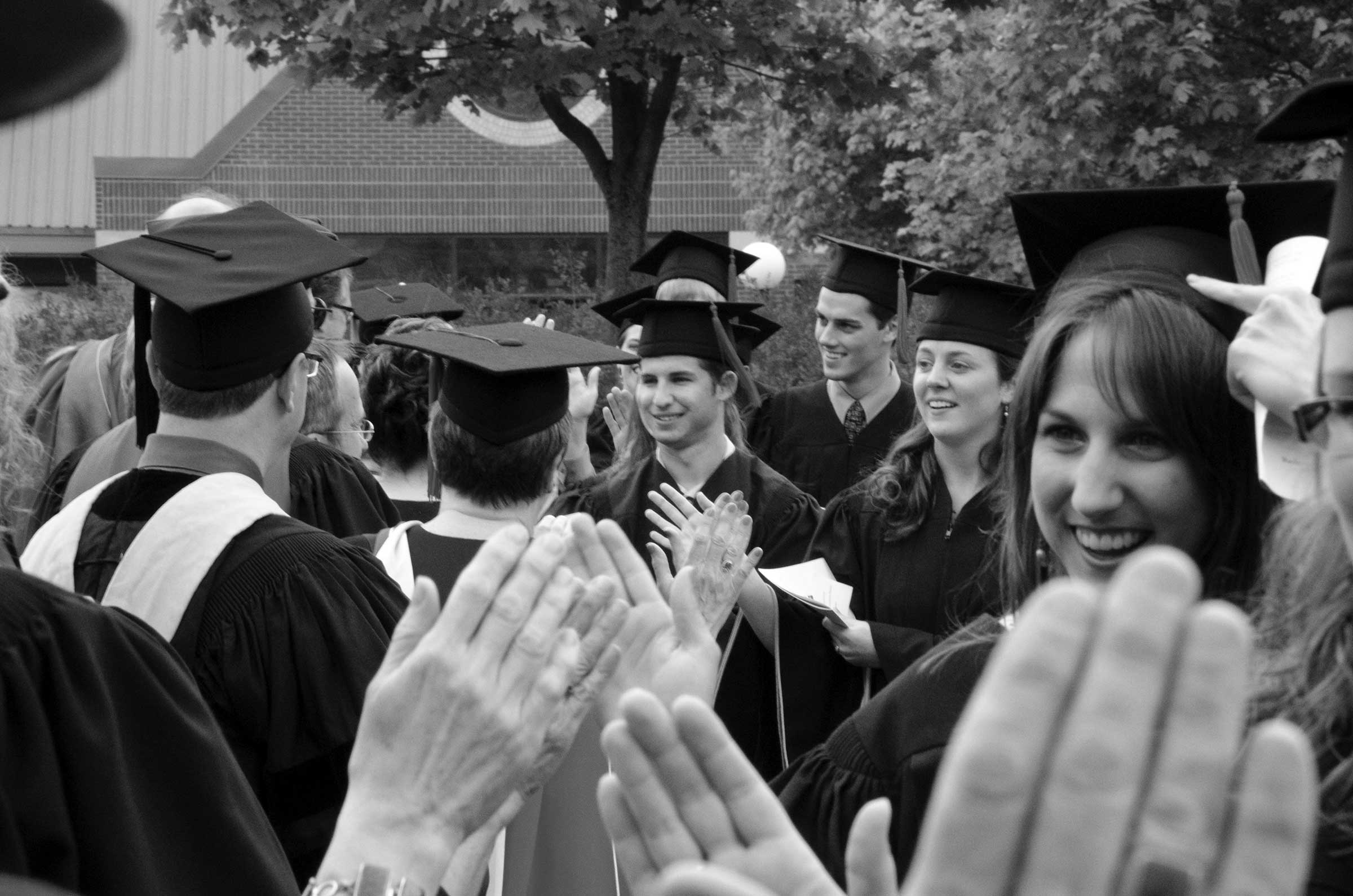
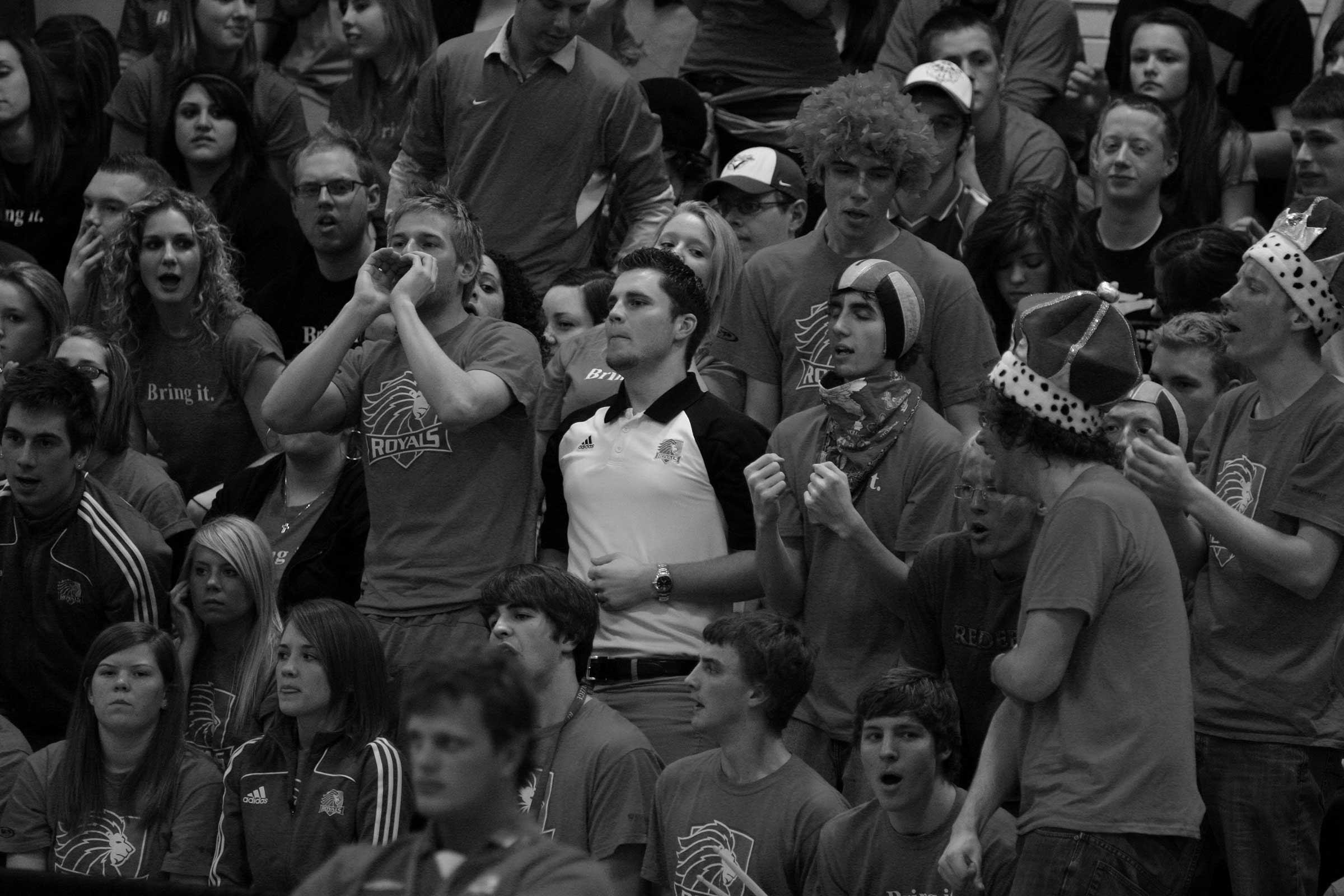
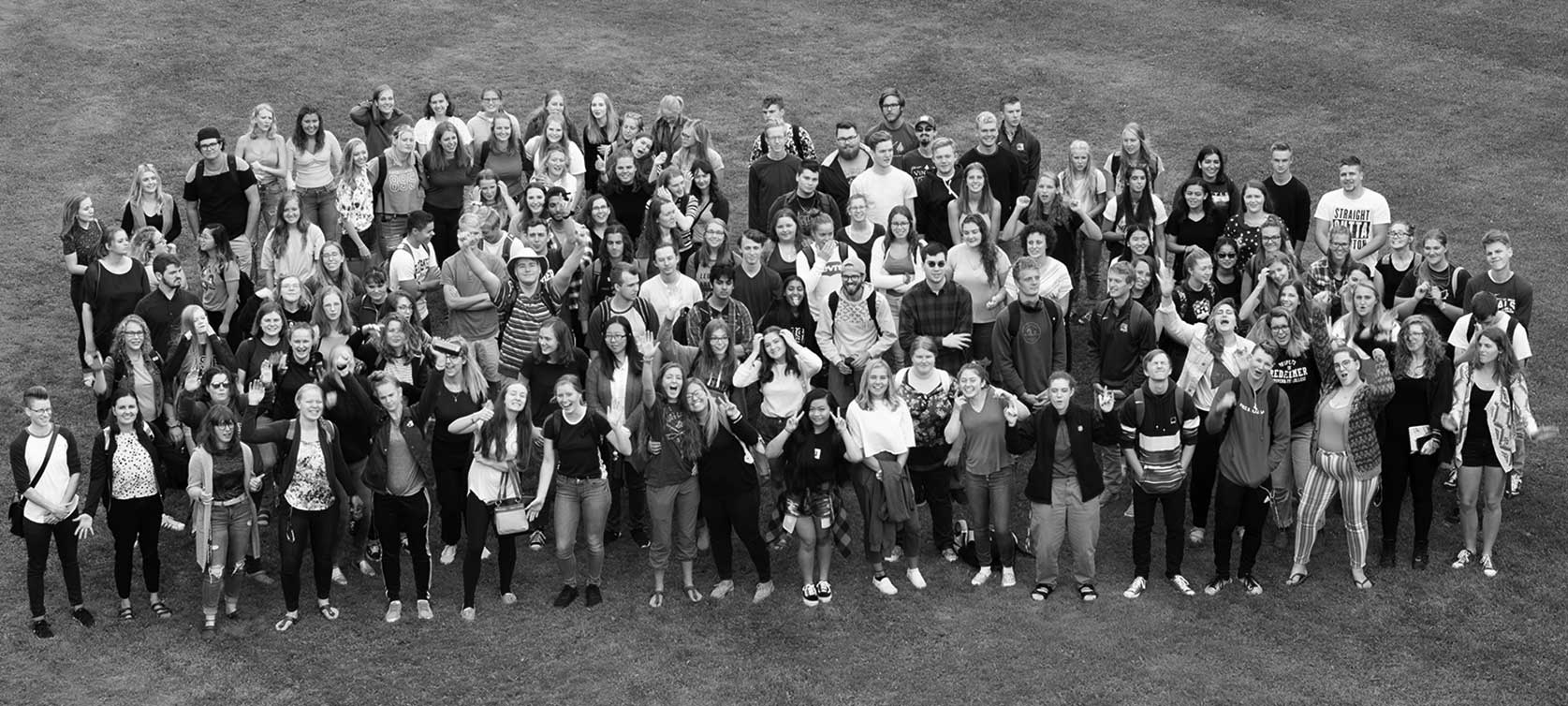
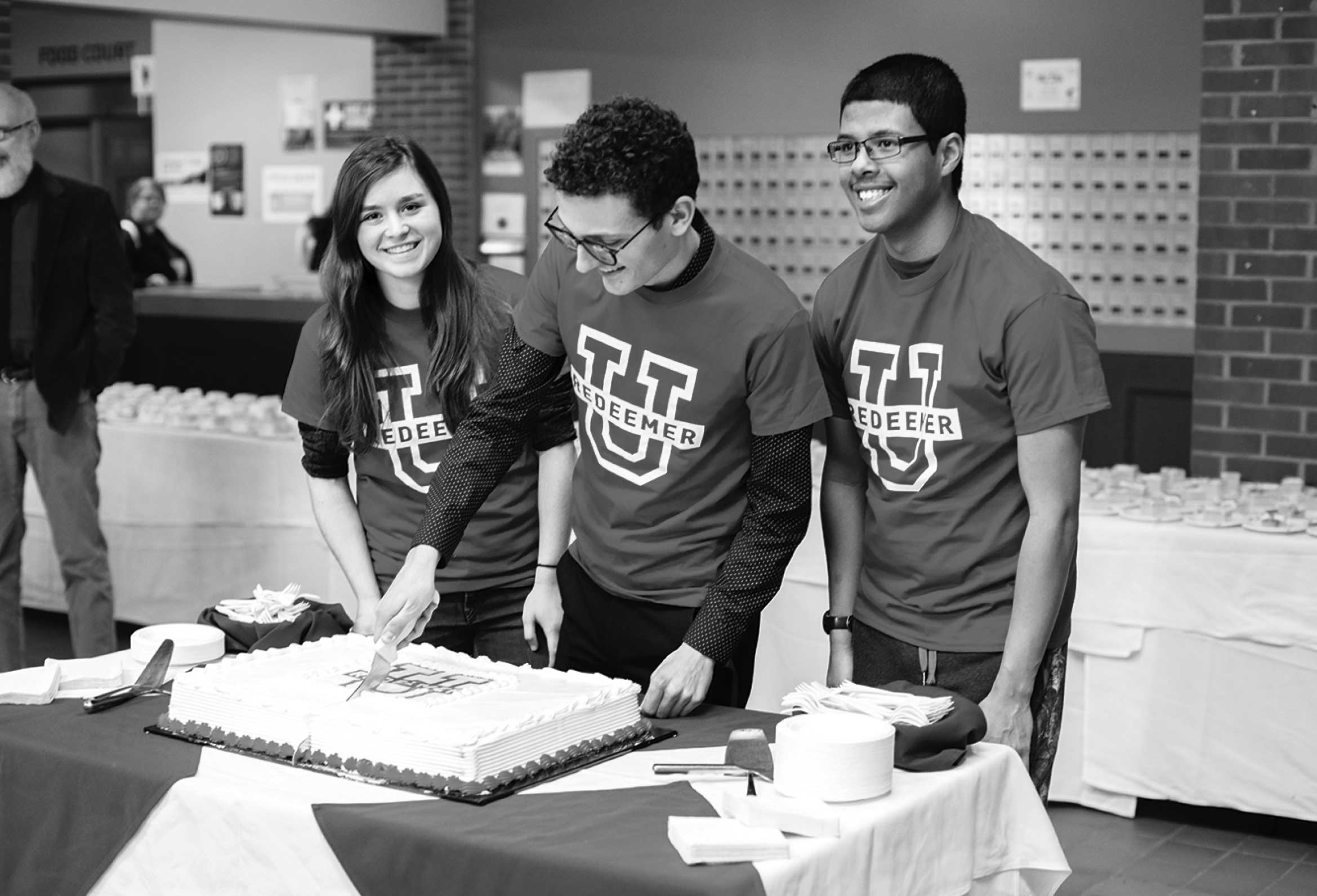
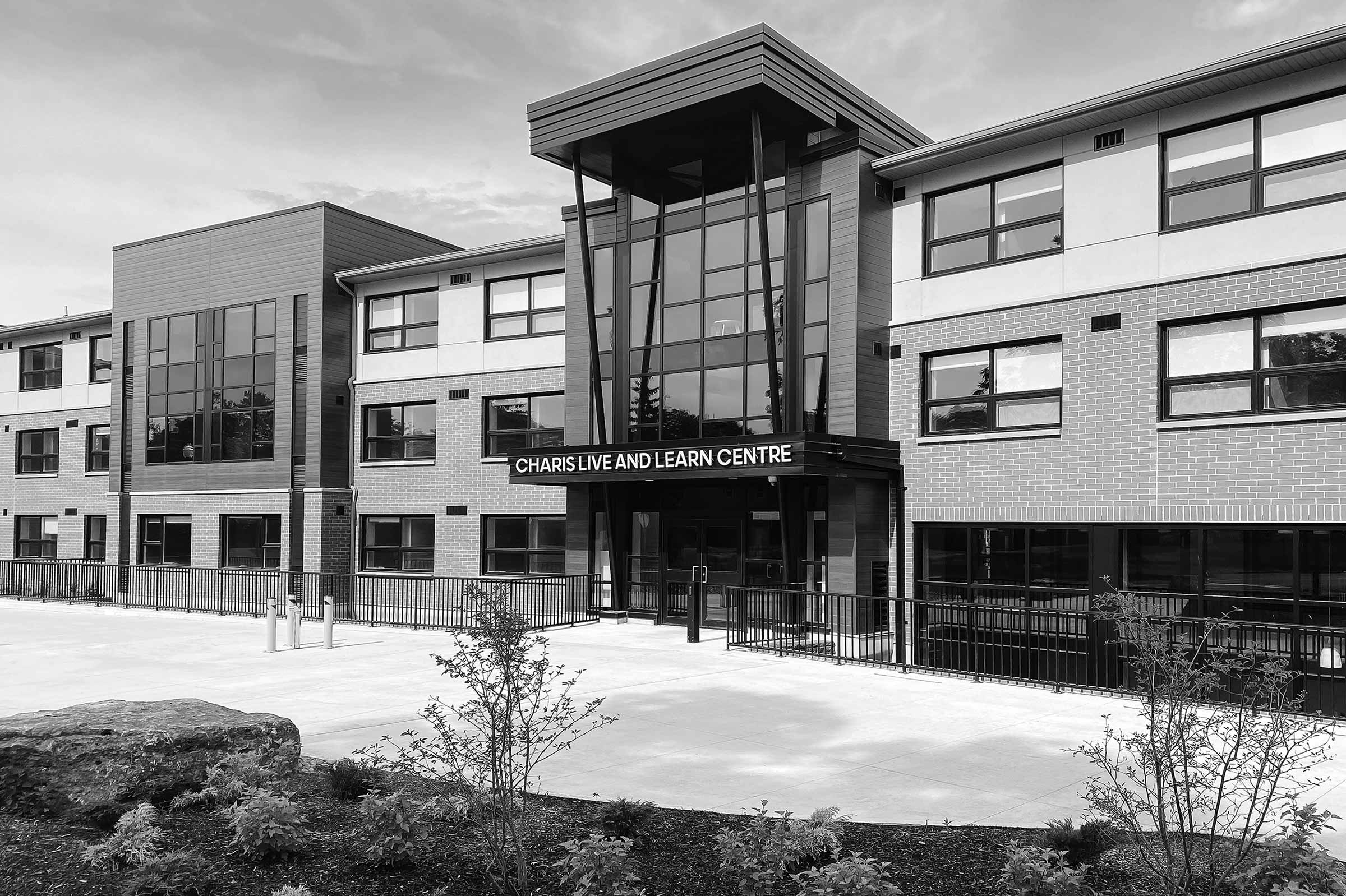
Celebrating 40 Years of God’s Provision
40 Years of Stories and Memories
Pre-opening
- 1976: Ontario Christian College Association (OCCA) is established with a distinctly Reformed constitution.
- 1980: Bill Pr 48 (The Redeemer College Act) passes officially recognizing Redeemer Reformed Christian College and its charter
- OCCA sets goal to open the college in 1982 in Hamilton
1976-1980
Pre-opening
In 1974, the idea of establishing a Reformed Christian college in Ontario was brought to Rev. Dr. Henry De Bolster of St. Catharines by a well-meaning Christian businessman. Intrigued, De Bolster formed a study committee to investigate the feasibility of such a project. In November 1976, the positive report of this committee led to the formation of the Ontario Christian College Association (OCCA) with a membership of 104 people. A board was elected to draw up a distinctly Reformed constitution for the college.
Over the next few years, the road to establishment was at times disheartening. Attempts at a suitable affiliation with local Ontario universities were unsuccessful, and with Bill 4 in February 1980, the government refused to grant the OCCA permission to run a privately-funded university college with a Christian perspective, based on its policy of restricting bachelor of arts and bachelor of science degree programs to publicly funded universities. When this was made law with the approval of Bill 4 in February 1980, OCCA sought to obtain a charter that achieved as much as possible in this context.
Finally, Bill Pr 48 (The Redeemer College Act) was passed in December 1980. The charter, drafted by OCCA members and legislative lawyers, officially recognized Redeemer Reformed Christian College and its authority to offer a liberal arts and sciences program leading to the bachelor of Christian studies degree (a bachelor of Christian education degree was also included for a potential teacher education program). Elated, the OCCA set a goal to open the college in two years’ time, feeling led to establish it in Hamilton.
- Rev. Dr. Henry De Bolster is selected to be Redeemer’s first president
- October 31 De Bolster is officially inaugurated at Centenary United Church in Hamilton on Reformation Day
- Fundraising, student recruitment and facility selection commence
1981
The appointment of a president was one of Redeemer Reformed Christian College’s first steps toward opening. Interviews took place in the early months of 1981, and De Bolster was selected to be Redeemer’s first president, effective June 1. Staff and faculty appointments followed. On October 31 - Reformation Day - De Bolster was officially inaugurated at Centenary United Church in Hamilton. Seven newly appointed faculty members were introduced to the audience. Dr. Joel Nederhoed of the Back-to-God-Hour gave the dedicatory address. Psalm 37:5 resonated with Redeemer’s new president: “Commit thy way unto the Lord; trust also in him; and he shall bring it to pass.”
For years afterwards, the unofficial theme song at Redeemer functions was the hymn, If Thou but Suffer God to Guide Thee. The project moved towards fulfilment as fundraising, student recruitment, and facility selection commenced. After an arduous search, student housing was made ready by renting a series of townhouses, an arrangement still visible in current dormitories (eight students per separate unit or townhouse).
- Redeemer College officially opens September 6 at Bell Cairn Memorial School on Beach Boulevard in Hamilton and townhouse residences on Francis Road in Burlington
- Approximately 1,700 people crowd Centenary United Church for opening convocation
- Redeemer receives official coat of arms and motto — Agnus Dei, Omnium Rex (Lamb of God, King over All)
- 97 full-time students and 63 part-time students begin their education
- Eight full-time faculty members begin serving
1982
Redeemer College officially opened on September 6, 1982. Over 1,700 people crowded Centenary United Church for the opening convocation. Redeemer’s official coat of arms and motto — Agnus Dei, Omnium Rex (‘Lamb of God, King over All’) — were presented to the community. Coming after several challenging years, the Lord’s provision was felt deeply by all at this monumental moment.
The college’s mission - to offer a liberal arts and sciences program based on a Reformed Christian perspective, emphasizing the lordship of Jesus Christ over all of life and learning - launched at the Bell Cairn Memorial School and townhouse residences in Hamilton on Beach Boulevard. Ninety-seven full-time students (a significant increase to the projected number of 50) and 63 part-time students commenced their education at these temporary facilities. They were a mainly Christian Reformed bumper crop.
Alongside De Bolster, eight full-time faculty members served in Redeemer’s early years, many of whom had left secure positions to be part of this new venture: Dr. John Bolt in theology; Hugh Cook in English; Dr. Justin Cooper in political science; Dr. Theodore Plantinga in philosophy; Dr. Harry Van Belle in psychology; Dr. Jitse Vander Meer in biology; Dr. Wytse Van Dijk in physics and mathematics; and Dr. Harry Van Dyke in history. Redeemer also became a member of the Council for Christian Colleges and Universities this year.
- Enrolment doubles to 150 students
- Four-year program solidifies with the first class to graduate in 1986
- Relationship with Au Sable Institute is established
1983
In its second official year, Redeemer College increased its enrolment significantly to 150 students. Consequently, the institution made the bold decision to solidify a four-year program, with the first class to graduate in 1986. Credit transfer arrangements with several public universities and Christian colleges were also secured for students needing programs the college didn’t offer.
The next few years saw growth in many areas. The Redeemer Royals won their first hockey game, having joined the Niagara Christian Hockey League. The college also began its relationship with the Au Sable Institute, which allowed biology and environmental science students to take specialized summer field courses through a collaborative program with Christian universities throughout the United States and Canada.
1984
In 1984, with continued strong growth in enrolment, the college began searching for larger, permanent facilities. Three new faculty members were also appointed. Dr. Jim Payton joined the history department, and Dr. Al Wolters joined the religion and theology department. Dr. John Boersema was hired as a full professor of business.
- 250 full-time and part-time students enrol
- 78 acres of land is purchased in Ancaster for new campus
- Association of Universities and Colleges in Canada (AUCC) grants Redeemer provisional membership
- Creation Regained: Biblical Basics for a Reformational Worldview by Dr. Al Wolters is published, becoming foundational in Redeemer’s core curriculum and to the Reformed tradition worldwide.
1985
By the 1985-86 academic year, Redeemer College reached an enrolment of 250 full-time and part-time students. It was time to expand for the future. In the early months of 1985, the college purchased 78 acres of land in Ancaster for the construction of a new campus. The groundbreaking ceremony took place on June 22. Psalm 127:1 was the guiding verse: “Unless the Lord builds the house, its builders labour in vain.”
Initially, a comprehensive academic building, 36 residence-style townhouses, 20 apartment-style units, and a student recreation centre were constructed at a cost of $13.3 million. Over the course of the next few years, seven additional townhouses and 20 apartments were added, along with the names Calvin, Luther and Cranmer –all reformers–for each of the residence court areas. A significant portion of the new campus was funded by generous donors and inspired investors. The confidence of Redeemer’s community in its mission to provide excellent Christian higher education was tangible.
It was also in 1985 that Redeemer College was granted provisional membership in the Association of Universities and Colleges in Canada (AUCC). Based on the positive report of a visiting team, including its finding that the courses leading to the bachelor of Christian studies were equivalent to university courses leading to the bachelor of arts and bachelor of science, the board of the AUCC gave its approval, marking another step towards Redeemer’s recognition by other Canadian universities and eventually by the Ontario government.
Creation Regained: Biblical Basics for a Reformational Worldview by Dr. Al Wolters was published this year. It became foundational in Redeemer’s core curriculum and to the Reformed tradition worldwide, having been translated into 12 different languages.
- Classes begin at new Ancaster campus
- 279 full-time students are welcomed into residences
- First graduating class of 41 students receives degrees
- Founding documents updated to refine Reformed identity and academic freedom
- Archeologist Art Howey identifies the site of future dome as a former Indigenous Attiwandaron (Neutral Peoples) village
1986
August 11, 1986 marked Redeemer’s official move from Beach Boulevard to the new Ancaster campus. With the help of many volunteers, the transition went smoothly. In September, the college welcomed 279 full-time students into its newly constructed residences.
On November 8, Redeemer College celebrated its new campus and the accomplishments of its first graduating class, who had delayed their graduation to be part of this event. Decked in traditional bachelor’s gowns, the 41 members of the class of 1986 received their degrees from president De Bolster at the official graduation ceremony. Dr. John Hulst, president of Dordt College in Iowa, gave an address on the topic “An Enduring Perspective”, and graduate Sylvia De Bruyne-Taekema spoke on behalf of her classmates about their experience of growth at Redeemer over the past four years. The convocation, attended by friends and supporters from near and far, marked a new beginning for Redeemer College, and the Lord’s favour was a great encouragement to the president, faculty, staff, students and supporting community.
The year 1986 also saw the assessment and refinement of some of the college’s academic policies in preparation for full membership in the AUCC. Questions around faculty appointment, Reformed identity and academic freedom were discussed, reviewed and expressed in updated documents.
During its construction, a significant discovery was made on Redeemer’s new campus. Near the gravel road leading to Kitty Murray Lane, an amateur archeologist identified the site of a much earlier Indigenous Attiwandaron (Neutral Peoples) village, likely consisting of a number of longhouses. Redeemer was now responsible to steward this find. Other artifacts were found on the campus and preserved, and each time there was new construction, the proposed site had to be investigated for any former Indigenous presence.
- Theatre department hosts first production, Lady Gregory’s Spreading the News
- Concert Choir forms
- Women’s volleyball wins Ontario Colleges Athletics Association (OCAA) Tier 2 Provincial Championship
- Redeemer College is officially granted ordinary membership in the AUCC with bachelor of Christian studies degree
1987
Redeemer’s academic and athletic programs continued to develop. In April 1987, the theatre department hosted its first production; Lady Gregory’s Spreading the News, directed by professor Ray Louter and performed by 10 enthusiastic students. The following September, Dr. Christiaan Teeuwsen joined the faculty of the music program, which had been started by Dr. Bert Polman the previous year. Redeemer’s Concert Choir formed soon after. The choir would host a number of memorable performances over the following decades. The college celebrated another achievement when the women’s volleyball team won the Ontario Colleges Athletics Association (OCAA) Tier 2 Provincial Championship, a first for Redeemer.
The final victory of 1987 came in October, when the AUCC officially and unanimously granted Redeemer College full membership. Redeemer’s bachelor of Christian studies degree programs were recognized as comparable to a bachelor of arts or science degree and were regarded as such by almost all post-graduate programs. With the admission of several Christian colleges, the AUCC also appointed Alvin Lee, president of McMaster University, to compose a statement on academic freedom, which proved to be well balanced with important attention to institutional autonomy, also for Christian colleges. When it was approved, Redeemer College accepted its principles and began to formulate a statement on academic freedom reflecting these developments which was finally completed in 1991.
- The Pascal Centre for Advanced Studies in Faith and Science is established
- Riel pipe organ from the Netherlands is installed in auditorium
1988
The The Pascal Centre for Advanced Studies in Faith and Science was established in August 1988 to examine relations between Christian faith and the natural sciences by means of education, outreach and research in the light of Scripture. At the direction of Dr. Jitse Vander Meer (biology), the Pascal Centre adopted the scientific library of the recently deceased Dr. Custance and organized international conferences and published papers on issues of faith and science. A bibliographic database on theology and science (which has since acquired over 35,000 entries) was established at a later date.
This year saw the installation of the Riel pipe organ from the Netherlands in Redeemer’s auditorium and the establishment of a fourth-year pre-seminary program in cooperation with Calvin Seminary in Grand Rapids, Michigan. In September 1988, 10 students took courses in preaching, public worship and ministry with Redeemer and Calvin professors. Although the program was discontinued a few years later, Redeemer’s seminary endeavour was a blessing to many at the time. Today, students continue to attend Redeemer enroute to further seminary training after earning a bachelor’s program of studies at Redeemer, which used to include instruction in the Dutch language, courses that were discontinued after the seminary dropped this unique requirement.
- Leadership Investment for Tomorrow (LIFT) fundraising campaign launches to raise $10 million
- Ruth Ann Dykstra is first recipient of the Faculty Award, for student who best exemplifies academic excellence, Christian leadership and active participation in life at Redeemer
- Official coat of arms is granted in a special ceremony attended by representatives of the Governor General’s office
1989
The Faculty Award was instituted and presented to the student who best exemplified academic excellence, Christian leadership and active participation in life at Redeemer. At the graduation ceremony in May, it was awarded to its first recipient, Ruth Ann Dykstra.
Having applied to Heraldry Canada to have its coat of arms registered, Redeemer was granted its official coat of arms, with slight modifications from the original design of 1982, in a special ceremony attended by representatives of the Governor General at the time, the Right Honourable Jeanne Sauvé. These framed pictures now hang in the president’s boardroom.
This year also saw the launch of the Leadership Investment for Tomorrow (LIFT) fundraising campaign. LIFT’s goal of raising $10 million to expand Redeemer’s scholarships and programs was surpassed in 1990, when a total of $11 million was raised.
Additionally, Hugh Cook was promoted to full professor of English this year.
- Elementary education program is implemented as part of Christian School Teacher’s Certificate (CSTC)
- New activities for students: blood donor clinics, SERVE projects in Haiti, Dominican Republic, and new Redeemer in France study-abroad program
- The women’s indoor soccer team wins OCAA gold
- Redeemer celebrates Ten Years of Learning is for Serving
1990
In September 1990, Redeemer implemented an elementary education program which met the requirements for the Christian School Teacher’s Certificate (CSTC), allowing students to receive teacher training for the elementary school level without having to go to Calvin College to complete the combined program. Dr. John Vriend was appointed to spearhead this program, and John Stronks was subsequently hired as a second faculty member.
1991
In 1991, a variety of new activities became available for Redeemer students: blood donor clinics, SERVE projects in Haiti and the Dominican Republic, and a new Redeemer in France study-abroad program. Three Redeemer students had the opportunity to study in Paris that year. Additionally, the women’s indoor soccer team again won OCAA gold, this time in indoor soccer.
The dominating event of 1991, however, was the unfortunate collapse of the Brookview Trust. The trust that had been set up to help fund student tuition needed to be terminated resulting in financial uncertainty. Despite the regrettable aftermath, by the grace of God, it was not the end of Redeemer College.
1992
Redeemer celebrated its 10th anniversary with a special event, reflecting on God’s faithfulness in enabling it to develop a wide range of academic programs, all under the banner of Learning is for Serving. Dr. Jitse van der Meer was promoted to full professor this year as well.
- Redeemer College becomes member of the Association for a Reformed University
- Concert Choir embarks on a tour in the Maritimes
1993
In April 1993, Redeemer College became a member of the Association for a Reformed University, later renamed the Association of Reformed Colleges and Universities, whose purpose was to foster cooperation among its 10 members. The Concert Choir embarked on a tour in the Maritimes that spring.
- Dooyeweerd Centre for Christian Philosophy is established
- Dr. Justin Cooper is inaugurated as second president after retirement of De Bolster
1994
The Dooyeweerd Centre for Christian Philosophy was established at Redeemer in 1994 after Herman Dooyeweerd Jr. approached the college with the idea for an institution dedicated to the translation and study of his father’s works. Leading Dooyeweerd scholar Daniel Strauss was its new director. The Centre’s main objectives are to translate Dooyeweerd’s works into English from the original Dutch, and ensure that his Reformed philosophical legacy continues to influence the academic world. For years following, the Dooyeweerd Centre held guest lectures, conferences and other initiatives at Redeemer. Its contributions to Redeemer’s Philosophy program were additionally significant, as it brought in qualified faculty and added translated works and new books to the library.
On October 21, Dr. Justin Cooper was inaugurated as Redeemer’s second president after the retirement of Rev. Dr. Henry De Bolster in the spring. De Bolster had led the college through its formative years with godly fortitude, and the baton was handed to Cooper, who had served Redeemer as a faculty member in political science and then as vice president, academic. A part of Redeemer from its infancy even before the doors opened in 1982, Cooper would lead Redeemer into its next chapter, overseeing a number of achievements during his term as president.
- Fall mainstage, Stranger in the Land, written and directed by Raymond Louter, tells story of the Netherlands’ experience in Second World War and subsequent emigration of thousands to Canada, with a record 2,200 people in attendance
- Matthew Cupido mural, based on Psalm 48, installed above front staircase; academic banners, designed by Willem Hart and sewn by Ina Kuntz, hung in the auditorium
- Church in the Box holds first worship evening in the Black Box
1995
The fall mainstage production by Redeemer’s theatre department was a notable event this year. Stranger in the Land, written and directed by the college’s own Raymond Louter, told the story of the Netherlands’ experience in the Second World War and of the subsequent emigration of thousands of Dutch people to Canada. A record number of 2,200 people were in the audience for its three performances, far more than any mainstage in Redeemer’s history. Louter’s production was a huge success, and subsequently went on tour across Ontario. Stranger in the Land was reworked and performed twice more in the coming years, most recently in 2021.
Redeemer’s academic building underwent several small updates: the Matthew Cupido mural, based on Psalm 48, was installed above the front staircase, and the four academic banners, designed by Willem Hart and sewn by Ina Kuntz, were hung in the auditorium. Additionally, Church in the Box held its first worship evening on January 29 in the Black Box Studio Theatre. Over the academic year the monthly event often overflowed its location, changing several times until eventually settling into the auditorium. In the years that followed, Church in the Box grew to regularly fill the 1,000-seat auditorium with Redeemer students, and many visitors from other churches, colleges and universities nearby.
This year Dr. Wayne Norman was promoted to full professor of psychology as well.
- 15th academic year with 34 full-time faculty and student enrolment of 442
- Redeemer passes 1,000 graduates after spring convocation
1996
Redeemer entered its 15th academic year with 34 full-time faculty and a student enrolment of 442. After graduation in the spring of 1996, the college boasted over 1,000 graduates and continued to grow at a steady pace. There was rich diversity and unity in Christ among students from 15 countries and 34 denominations (two-thirds from a Reformed background, and one-third from the broader Evangelical Christian community. Catholic students also began to attend at this time). Student life at Redeemer flourished as the decade turned towards the new millennium.
1997
In 1997, the provincial government commissioned a committee to study the possibility of allowing private universities to operate under specific conditions. The positive report of this committee, revived Redeemer's discussions with the government about changing its degree designations to the bachelor of arts and bachelor of science, which were to bear fruit with the appointment of a special visiting team to review Redeemer's programs, faculty, academic policies and facilities.
1997 saw another milestone: the Concert Choir, directed by Dr. Christiaan Teeuwsen, went on tour to British Columbia. The choir also recorded a limited edition CD in Chatham this year.
- Building on the Promise fundraising campaign launches to expand academic programs and facilities while keeping tuition fees lower
- Ontario government passes Bill Pr17 — An Act respecting Redeemer Reformed Christian College — granting authority to offer full bachelor of arts and bachelor of sciences degrees
- Concert and Alumni Choirs release first CD
- Redeemer faculty become eligible for grants from National Sciences and Engineering Research Council (NSERC), Canada’s largest research funding body
1998
In 1998, the fundraising campaign, Building on the Promise, was launched to expand Redeemer’s academic programs and facilities while keeping tuition fees lower.
A significant victory in government relations defined the year. On June 25, based on the positive report of the visiting team, the Ontario government passed Bill Pr17 — An Act respecting Redeemer Reformed Christian College — which granted Redeemer the authority to offer full bachelor of arts and bachelor of sciences degrees in place of the bachelor of Christian studies degree. This decision officially recognized Redeemer College’s programs on the same level as other Ontario universities.
A number of faculty members were promoted to full professorship this year: Dr. Henry Brouwer professor of chemistry, Dr. Gary Chiang professor of biology and Dr. Jim Payton professor of history. The continued scholarship of Redeemer’s faculty and Research Centres, along with the wide acceptance of our graduates, solidified the institution's academic and scholarly reputation.
1999
Several moments stand out in 1999. The first was the release of the Concert Choir and Alumni Choir’s first CD. The second was the installation of new gardens in the front quad, which crowned Redeemer’s already-lovely outdoor campus. In addition, after Redeemer had been granted eligibility the previous year, several science faculty members received the first research grants from NSERC (National Sciences and Engineering Research Council). Previously, AUCC membership had opened the door for grants from SSHRC (Social Sciences and Humanities Research Council), as well as from the Canada Council for the Arts. Now Redeemer was recognized by all of the Tri-Council funding agencies. Many successful projects and initiatives were supported in succeeding decades based on this achievement, such as two awards in summer 2021 enabling student research using PCR testing.
- Ontario legislature passes Bill Pr19 and approves institutional name change to Redeemer University College
- Augustine Hall three-storey residence opens
- Whaley Teaching Garden is established, named in honour of property’s previous owner
2000
The turn of the millennium marked a new era for Redeemer College, building on its amended charter two years prior. On June 22, the Ontario legislature approved an institutional name change: Redeemer College officially became Redeemer University College. This charter amendment, known as Bill Pr19, significantly elevated Redeemer’s academic status, placing it alongside other institutions that offered undergraduate university programs, and also opened new opportunities for graduates.
Additionally, Redeemer University College celebrated the opening of the Augustine Hall residence, which expanded on-campus housing opportunities for students, and the establishment of the Whaley Teaching Garden, named in honour of the property’s previous owner. The year 2000 closed with a strong sense of God’s favour within the Redeemer community.
- Canada Council Poetry Readings is established with aid of annual grant from Canada Council for the Arts in collaboration with Hamilton Poetry Centre
- Outdoor tennis and basketball courts are constructed
- HSR begins transit service directly to campus
2001
A number of positive developments occurred at Redeemer University College from 2001 to 2002. Canada Council Poetry Readings were established. With the aid of an annual grant from the Canada Council for the Arts and in collaboration with the Hamilton Poetry Centre, Redeemer began to host a number of Canadian poets yearly for poetry readings, book signings and Q&As. Redeemer’s outdoor tennis and basketball courts were constructed, increasing opportunities for student recreation and Redeemer athletes to hone their skills on campus. The HSR, formerly Hamilton Street Railway, began regular bus service to Redeemer in 2001 as well, connecting off-campus students, staff and faculty directly to the campus via a reliable public transportation network.
Dr. John Byl was promoted to full professor of physical education and Dr. Harry Van Dyke to full professor of history.
- Redeemer celebrates 20 years of God’s faithfulness
- Williams Coffee Pub opens on campus
- Oxford-Crandall Study Abroad program is established
- First coffeehouse event is held, a conglomerate of musical and miscellaneous-talent performances
2002
In 2002, the Redeemer community celebrated 20 years of God’s faithfulness with further growth. Williams Coffee Pub opened, providing a much-needed coffee outlet on campus with breakfast and lunch options. The Oxford-Crandall Study Abroad program, which offered students from Redeemer and other Canadian Christian colleges the opportunity to spend a term studying at Oxford University with access to the world-famous Bodleian Library, was established. Eighty Redeemer students have since participated in once-in-a-lifetime off-campus academic experiences, including those available through Redeemer’s membership in the CCCU. Redeemer’s first coffeehouse event was also held in 2002; a conglomerate of musical and miscellaneous-talent performances, coffeehouse quickly became a campus tradition for humour and fellowship.
- Ontario government passes Bill Pr14, granting Redeemer authority to offer full bachelor of education degree replacing bachelor of Christian education degree
- The Cross and Our Calling is crafted to fully express Redeemer’s religious identity and founding vision
- New B.Ed. program is granted initial accreditation by the Ontario College of Teachers (OCT), giving Redeemer the only provincially recognized Christian teacher education program
- Dr. David Koyzis publishes Political Visions & Illusions: A Survey & Christian Critique of Contemporary Ideologies becoming an important contribution to distinctly Christian modern political thought
2003
On June 26, the Ontario government passed Bill Pr14, which granted Redeemer the authority to offer a bachelor of education degree to replace its bachelor of Christian education degree on the condition that its teacher education program was accredited by the Ontario College of Teachers (OCT). On December 10, Redeemer was invited to submit an application to have the new B.Ed. program reviewed for initial accreditation by the OCT, a lengthy process involving the submission of documentation and a review by a visiting team.
The Cross and Our Calling was crafted as a statement to give fresh expression to Redeemer's religious identity and founding vision making them more accessible for both the campus and the wider communities. Building on the institution’s Objects and Purposes, Statement of Basis and Principles, Educational Guidelines, Guidelines on Reformed Christian Perspectives, and Mission Statement, The Cross and Our Calling was published in 2003 and added to this group of foundational documents.
Dr. David Koyzis was promoted to full professor of political science this year and his seminal book, Political Visions & Illusions: A Survey & Christian Critique Of Contemporary Ideologies was published and became an important contribution to distinctly Christian, modern political thought.
- The Drama of Scripture: Finding Our Place in the Biblical Story by Dr. Craig Bartholomew and Dr. Michael Goheen is published, quickly becomes a hallmark of Redeemer’s core program
2004
Redeemer’s education program was fully accredited by the OCT in 2004, giving Redeemer University College the only provincially recognized Christian teacher education program and enabling graduates to receive the Ontario Teachers Certificate and to teach in Catholic, public or Christian schools.
This year also saw the publication of The Drama of Scripture: Finding Our Place in the Biblical Story (Baker Academic) by Dr. Craig Bartholomew and Dr. Michael Goheen, which quickly became a hallmark of Redeemer’s core program and remains still to this day. The theatre program marked another milestone with the performance of Shakespeare’s Macbeth as its spring mainstage. The ambitious achievement attracted a large audience once again.
Dr. Guenther Haas was promoted to full professor of religion and theology this year.
- South wing addition is completed, consisting of lecture halls and expanded library named the Peter Turkstra Library
2005
A wave of excitement swept through the Redeemer community in 2005, as funds were raised to construct an expansion of the college’s academic facilities. Plans for a south wing addition, consisting primarily of lecture halls and an expanded library, were undertaken. Following a summer flurry, the renovations were completed for the new academic year. On November 28, the new Peter Turkstra Library opened to the excitement of students, staff and faculty alike. The enlargement of both physical space and academic resources for Redeemer University College marked a crucial milestone in the institution’s history.
Dr. John Van Rys was hired as full professor of English this year.
- Second entrance at Kitty Murray Lane is constructed
- Enrolment Initiative Fund launches to go beyond current 850 students
2006
In 2006, Kitty Murray Lane was upgraded, giving Redeemer a second entrance. The institution launched a new campaign to raise enrolment, which stood at 850 students. The Enrolment Initiative Fund, which froze tuition for the 2006-2007 academic year and increased scholarship opportunities, was implemented to bolster future student recruitment. A fundraising golf tournament was also held for the first time to raise support for Redeemer.
- 25th anniversary is celebrated at commemorative event
- 185 graduate; — the largest class to date
- Employers hiring Redeemer co-op students become eligible for provincial tax credit
2007
Redeemer University College celebrated its 25th anniversary in 2007 with a tree-planting ceremony on school grounds, followed by a commemorative community event on September 29 to thank its 2,700 alumni, current students and community supporters. This year also boasted the largest graduating class to date 185 graduates received their degrees on May 26. The university enjoyed another important recognition when employers hiring Redeemer co-op students became eligible for a provincial tax credit.
- Royals win their first gold in men’s indoor soccer
- Final excavation of the Attiwandaron (Neutral Peoples) village is completed with over 50,000 unique artifacts discovered at the site since 1987
2008
An athletic milestone was reached when the Redeemer Royals won the provincial OCAA championship in men’s indoor soccer, marking the first men’s gold medal win. This year also marked the beginning of the excavation of what was discovered to be a Indigenous Attiwandaron (Neutral Peoples) village dating to 1325 and likely consisting of at least 5 longhouses and possibly 3 more with a palisade. Many unique artifacts were found at this site, including arrow heads, various tools, jewellery, ceramic vessels and a pipe, adding to the many artifacts found on campus since 1986, some of which are on loan to Redeemer. With the excavation completed, plans could go ahead for what would become the Redeemer Sports Complex. This was part of what became a larger effort to upgrade the campus sports facilities and academic building, spurred on by the federal government's announcement of a one-time capital program for universities called the Knowledge Infrastructure Program (KIP).
- $2.9 million is received to fund capital projects such as solar panels (installed in 2011), from the Government of Canada’s Knowledge Infrastructure Program (KIP); first time Redeemer receives government grant of any kind
- Continuous Learning and Education at Redeemer (CLEAR) program launches, offering courses, workshops, lectures and excursions to the community to expand educational mission
2009
Redeemer received $2.9 million to fund capital projects, such as the installation of solar panels on the academic building (installed in 2011), from the government of Canada through the Knowledge Infrastructure Program (KIP). This investment marked the first time Redeemer received a government grant of any kind. Given this impetus, the province also contributed $3 million for the Sports Complex along with a $1 million interest-free loan from the City of Hamilton, a unique cooperation among all three levels of government. Another $2.5 million in private funds was raised from the local community and Redeemer’s supporters for these projects, as well as the renovation of the administrative wing of the academic building, reaching a total of almost $10 million.
The Continuous Learning and Education at Redeemer (CLEAR) program was launched in the fall through another special grant, offering courses, workshops, lectures and excursions for mature learners in the community as a way to expand Redeemer’s educational mission. (The program achieved its educational goals for a number of years but was discontinued.)
- Dr. Justin Cooper retires after 30 years of service (president for 16 years)
- Dr. Hubert Krygsman is appointed third president
- Dr. Jim Payton publishes Getting the Reformation Wrong: Correcting Some Misunderstandings, an important acknowledgement of the modern Church’s connection to the early Church
- Redeemer Sports Complex opens with one of the largest soccer domes in Ontario
2010
On June 30, Dr. Justin Cooper retired after 30 years of service at Redeemer, serving as president for 16 years. Hundreds of supporters gathered in the auditorium to see Cooper off and celebrate his remarkable legacy at Redeemer and in the broader Hamilton community. Dr. Hubert Krygsman was appointed as the third president of Redeemer University College, effective June 14. Krygsman, who previously served as the associate provost of Dordt College in Iowa, came to Redeemer with the mandate to strengthen Redeemer’s reputation, develop more ties between the institution and the broader community, and bolster enrolment and academic growth.
Several faculty members were promoted to full professorship this year as well: Dr. Deborah Bowen became professor of English, Dr. Kevin Vander Meulen professor of mathematics, and Dr. James Vanderwoerd professor of social work.
Jim Payton published Getting the Reformation Wrong: Correcting Some Misunderstandings, an important acknowledgement of the modern Church's connection to the early Church.
Another exciting development was the opening of the Redeemer Sports Complex, a new soccer dome that was one of the largest of its kind in Ontario. In partnership with the Ancaster Soccer Club, Redeemer had campaigned to raise the funds needed to build this world-class facility to be enjoyed by Redeemer athletes and players and teams from across southern Ontario. The completion of the adjoining outdoor turf soccer field, now named the David Mantel Field, was also part of this project.
- Renovations are completed on administrative wing
- Grant from Stronger Together is received to develop student-led community support organization called Redeemer Downtown
2011
In 2011, renovations were completed on the administrative wing, putting admissions and student services on the ground floor to better welcome students. Redeemer received a grant from Stronger Together, a grant-giving organization for charities, to develop a community support organization called Redeemer Downtown. The student-led organization coordinated activities to address the needs of Hamilton’s downtown core. Susan Van Weelden was promoted to full professor of business.
- Redeemer University College celebrates 30 years of Reformed Christian higher education
- Health sciences program launches
2012
Redeemer University College celebrated 30 years of Reformed higher education in 2012. The community reflected on God’s provision over the past three decades, and looked forward to many more years to come. This year Redeemer officially launched its health sciences program — a significant milestone for the science department. Dr. Christina Belcher was promoted to full professor of education.
- Dr. Derek Schuurman’s Shaping a Digital World: Faith, Culture and Computer Technology is published, considering the relationship between faith and computer science.
2013
Dr. Derek Schuurman’s Shaping a Digital World: Faith, Culture and Computer Technology was published, filling an important role for technology readers considering the relationship between faith and computer science. Unfortunately, a pattern of declining incoming student enrolment was beginning and would continue for a number of years, leading to difficult decisions over the next half decade. Led by associate Provost Dr. David Zietsma, a cross-divisional faculty and staff team began work on a complete reassessment and ultimately restructuring of Redeemer’s Core program, the heart of the undergraduate experience.
- 2020 Strategic Plan is adopted with ambitious goal to raise $20 million by 2020
- Distinguished Alumni Award is established to recognize alumni who make significant contributions in their field and demonstrate Christian commitment in their work and community; Graham Cubitt ’01, director of projects and development at Homestead Christian Care (now Indwell), is first recipient
2014
In June, Redeemer’s Board of Governors adopted the 2020 Strategic Plan with the ambitious goal to raise $20 million by 2020. Amidst pressure from the financial shock waves reverberating from the 2008 financial crisis, declining enrolment and debate over the value of a liberal arts and sciences education in the marketplace, Redeemer employed a strategy to achieve financial stability and deepen the impact of its academic program.
The Distinguished Alumni Award, which recognizes alumni who made significant contributions in their fields of enterprise while demonstrating Christian commitment in their work and communities, was established. Graham Cubitt (class of ’01), director of projects and development at Homestead Christian Care (now Indwell), was its first recipient.
- Centre for Christian Scholarship is established (now the Albert M. Wolters Centre for Christian Scholarship)
- New media and communications studies program launches (MCS)
- Owen Kurvits wins CCAA National Championship in men’s singles badminton; later named the first three-time Male Player of the Year in OCAA history
2015
Some of the initial steps of the 2020 Strategic Plan were launched this year, including Senate’s passing of the redeveloped Core (to launch in 2016) and the Centre for Christian Scholarship (now the Albert M. Wolters Centre for Christian Scholarship), dedicated to fostering the work of Christian scholarship in Canada and leveraging that work for public impact. Dr. Robert Joustra, assistant professor of international studies, was appointed as its director, with an ambitious vision to maximize Redeemer’s scholarly impact.
In March, Owen Kurvits won the Canadian Collegiate Athletic Association (CCAA) National Championship in men’s singles badminton. He went on to be named the first three-time Male Player of the Year in OCAA history.
In September, Redeemer launched a modern new website and a new media and communications studies (MCS) program. The Redeemer in France program was reworked, shifting to Montpelier in the south of France for the following year. In November, Dr. Edward Berkelaar was formally installed as professor of chemistry and environmental studies, and in December, Rev. Dr. Ken Herfst accepted a tenure-track appointment to the department of religion and theology in preparation for the new urban and intercultural ministry program. After serving as associate provost for curriculum and dean of humanities, Dr. David Zietsma was appointed vice president of marketing and enrolment.
- Rev. Dr. Henry De Bolster, founding president, passes away; Redeemer commemorates his leadership, faith and courage
- President Dr. Hubert Krygsman steps down in October
- New core curriculum launches with set of 10 courses for every student to deepen their faith into all areas of life as they prepare for their chosen disciplines
- Resound (in print and online) replaces former flagship magazine, Tangents
- Curtiss Straatsma (women’s volleyball) is named OCAA Player of the Year — first in Redeemer’s history
2016
The community commemorated the leadership, faith and courage of Rev. Dr. Henry De Bolster, Redeemer’s founding president, who passed away in April. Redeemer students, faculty staff and many others gathered to pay tribute to De Bolster in a memorial service that month.
With a community grateful for the progress made under his leadership, Dr. Hubert Krygsman stepped down as president at the end of October. During his tenure he helped to preserve Redeemer’s mission, begin reducing Redeemer’s long term debt, and begin new program initiatives such as the Core program and the Health Sciences program. Vice president of finance and administration Fred Verwoerd was appointed as interim president and the search for a new president commenced.
To enhance the value of its liberal arts and sciences education, Redeemer launched a new core curriculum for students in the fall, dramatically changing the undergraduate experience. Designed from the ground up as a unique set of 10 courses (formerly they were existing courses from all disciplines), the core was honed to prepare students to thrive in a rapidly changing world and to deepen their faith as they pursued their chosen disciplines.
In October, Resound magazine replaced Redeemer’s former flagship magazine, Tangents. Resound, published digitally and in print as a multichannel, content-sharing platform, aimed to reflect Redeemer’s mission and God’s amazing work through Redeemer and its graduates.
An athletic achievement was celebrated this year as well. Curtiss Straatsma (women’s volleyball) was named OCAA Player of the Year — the first female Player of the Year in Redeemer’s history.
In the spring, Dr. Kyle Spyksma was appointed as acting vice president academic (later to become interim in 2018 as the university conducts a search.)
- Re campaign launches as public fundraising initiative for the 2020 Strategic Plan
- Centre for Experiential Learning and Careers launches (CELC — now the Career Centre)
- Redeemer partners with McMaster University, Mohawk College and the City of Hamilton to launch CityLAB, providing students with interdisciplinary projects that have a tangible, positive impact on the city
2017
In February 2017, Redeemer’s sociology/social work program was relaunched as applied social sciences. In March, the Re campaign was launched as the public fundraising campaign for the 2020 Strategic Plan, which aimed to renew Redeemer’s academic programs, institutional profile and resource management. As part of the initiative, the Centre for Experiential Learning and Careers (CELC - now the Career Centre) was launched on March 2. The Centre aimed to triple the number of programs with co-op and experiential learning opportunities and help students connect their calling with individualized career guidance.
In December, in partnership with McMaster University, Mohawk College and Redeemer University College, the City of Hamilton launched a pilot program - CityLAB - to develop interdisciplinary projects for students’ core capstone courses, and to increase partnership between the City of Hamilton and the science department’s local water-monitoring projects. Redeemer’s hope was that the new partnership would allow students to have a tangible, positive impact on the city. CityLAB continues to be a significant program for Redeemer students.
Several faculty promotions occurred this year: Dr. Christiaan Teeuwsen became full professor of music and Dr. Doug Needham full professor of psychology.
- Urban and intercultural ministry program launches, weaving together missions, theology and practical ministry tools
- Business professors Busuttil and Van Weelden’s best-selling business textbook, Banff Aspen Lodge is incorporated into curriculum at Harvard Business School
- Dr. Robert Graham is appointed as Redeemer’s fourth president
2018
In March, Redeemer launched its new program in urban and intercultural ministry, which weaved together missions, theology and practical ministry tools for students looking to share their faith with the world. Business professors Busuttil and Van Weelden celebrated the success of their best-selling business textbook, Banff Aspen Lodge, which was incorporated into the curriculum at Harvard Business School.
In the summer, Dr. Robert Graham was appointed as Redeemer’s fourth president bringing 10 years of experience in senior leadership at two well-respected Christian universities. His work commenced in August as he joined discussions for Redeemer’s next strategic plan, with his inauguration planned for the following spring.
- Major tuition and fee restructuring is announced with 42 per cent tuition reduction for Canadian undergraduate students, prompted by a generous $11 million donation
- Eight-month Christian gap year program, Act Five, is launched in collaboration with five Christian high schools
- Re campaign raises $18.5 million, the most successful campaign in Redeemer’s history
- Fall enrolment sees 14.5 per cent increase welcoming second largest incoming class in the school’s history
2019
In February, Redeemer announced a major tuition and fee restructuring that saw a 42 per cent tuition reduction for Canadian undergraduate students. Prompted by a generous $11 million donation to make Christian university education more affordable, tuition was to remain flat until the 2023-2024 academic year. Additionally, the Re campaign realized 90 per cent of its goal ($18.5 million) in January 2019, making it the most successful fundraising effort in Redeemer’s history. Fall 2019 enrolment saw a 14.5 per cent increase welcoming the second largest incoming class in the school’s history.
In March 2019, Redeemer announced the launch of an eight-month Christian gap year pilot program, Act Five, to commence in the fall in collaboration with five Christian high schools. Act Five’s mission is to offer young adults the chance to explore how their faith fits into a rapidly changing world, with opportunities to travel, study, worship, live and serve together. (In the spring of 2022, Act Five launched as an independent organization.)
Dr. Karen Dieleman was promoted to the position of full professor of English; Dr. Adam Barkman became full professor of philosophy, and Dr. Russell Kosits full professor of psychology.
- Provincial ministerial consent received to officially change name to Redeemer University; Bill 213 provides greater degree granting authority with 20 new possible degrees including nine possible masters
- Dual-delivery model developed to maximize in-person learning while offering remote options as a result of the COVID-19 pandemic
- Learn. Forward. Redeemer’s 2025 Strategic Plan launches with vision for Kingdom-centred, innovative graduates making a profound impact in a complex, digital world
- Institutional rebrand is unveiled with modern logo and refreshed colours; Redeemer Royals varsity sports is also refreshed
- Enrolment increases 13.5 per cent welcoming 358 students in the largest incoming class in Redeemer’s history
2020
On January 20, the university announced the appointment of Dr. David Zietsma as provost and vice president, academic. On the same day, Redeemer University College received ministerial consent from the Ontario government to officially change its name to Redeemer University, as well as the authority to grant 20 new university degrees at the undergraduate and graduate level. This was a remarkable achievement for the institution, officially acknowledging Redeemer’s identity and the kind of education it had been providing since its inception. The name change opened the way for an institutional rebrand that was unveiled in August with a modern logo and refreshed institutional colours. Redeemer Royals varsity sports also received a brand refresh aligning colours and common symbols across the university brand.
In March, the COVID-19 pandemic hit. In the span of a week, students moved out of residence and instruction moved online. Faculty and staff began working remotely as the world began to grapple with massive upheaval. Students finished their semester online, and Redeemer pivoted quickly over the summer to develop a dual-delivery model that maximized in-person learning while offering remote options at the same time for the fall.
In the late spring, Redeemer publicly launched Learn. Forward. Redeemer’s 2025 Strategic Plan with a vision for Kingdom-centred, innovative graduates making a profound impact in a complex, digital world. Several major initiatives were already well underway as evidenced by the charter change in January and developing plans for a new mixed-use facility and a rebrand.
The new Redeemer App to connect everyone and everything on campus was introduced over the summer months. Designed to improve the student experience by providing access to information, announcements, files, financial data, campus services and more from their smartphone or laptop, the app significantly improved internal communication for the Redeemer community over the following years.
In the fall, ground was broken for the new residence and learning facility to accommodate ongoing and future enrolment growth. With enrolment up 13.5 per cent over the previous year, Redeemer welcomed its largest incoming class in history, with 358 new students for the 2020-2021 academic year. In December, the Ontario Legislature passed Bill 213, amending Redeemer’s charter to include the recent name change and officially provide greater degree-granting authority with 20 new possible degrees, including nine possible masters degrees.
Several faculty changes commenced this year as well. Dr. Murray Stiller was hired as full professor of media and communications studies, Dr. Kevin Flatt was promoted to full professor of history and Dr. Darren Brouwer was promoted to full professor of chemistry.
- President Dr. Robert Graham steps down due to health and family concerns
- School of Education and School of Business launch with new bachelor of business administration (BBA) degree
- Another strong incoming class pushes enrolment past 1,000 students for the first time
- Campus bookstore relaunches as 21Five
2021
The excitement and growth of 2020 carried on into 2021. Despite the challenges of the ongoing pandemic, students, staff and faculty adjusted to and continued learning with Redeemer’s advanced dual-delivery system. In April, Dr. Robert Graham stepped down as president for family and health reasons related to a stroke suffered in 2019. Provost Dr. David Zietsma was appointed as interim president, and the search for a new president began. Dr. Kyle Spyksma took on the interim vice president, academic role.
In July, Redeemer won a significant legal battle against the federal government for denying Redeemer’s participation in the Canada Summer Jobs Program, along with several other institutions, for their inability to sign a special attestation newly added in 2019 regarding support for abortion. The court ruled that Redeemer be granted access to the program’s wage subsidies, and that the federal government pay Redeemer’s legal costs.
As part of the Learn. Forward. 2025 Strategic Plan to innovate for student and graduate success, Redeemer made significant changes to its academic structure this year, including the new discipline-specific School of Business and School of Education that would launch in the fall. A new bachelor of business administration (BBA) degree came with it, marking the first new degree since the bachelor of education in 2003. Recognizing shifts in student expectations as well as financial challenges common to higher education, after a systematic review of its program array Redeemer’s Senate made the difficult decision to discontinue programs in French studies and theatre arts due to flat or declining enrolment and shrinking market demand.
In September, another strong incoming class pushed Redeemer’s enrolment past 1,000 students for the first time: a remarkable achievement for the small but rapidly growing university. The campus bookstore relaunched as 21Five that same month, offering the community a bright new space to shop and study.
- The $22-million Charis Live and Learn Centre opens for living and studying, with new paved parking lots from the main building to Augustine Hall
- Dr. David Zietsma is appointed Redeemer’s fifth president
- New bachelor of kinesiology and two new music degree programs launch
- Redeemer celebrates its 40th anniversary!
2022
In January, the Charis Live and Learn Centre opened, providing three floors of student residences, as well as classrooms, lounge space and housing the new Innovation Centre. The grand opening ceremony took place on April 1 and welcomed municipal, provincial and federal government representatives, along with the Redeemer community. At the time of opening, $11.3 million had been raised for the $22 million project. New paved parking lots with parking gates became fully operational later in the spring and included charging stations for electric vehicles.
In March, Redeemer announced the appointment of its fifth president, Dr. David Zietsma. A new bachelor of kinesiology and two new music degree programs were announced in the spring, as well as a new minor in law and public policy.
In fall 2022, Redeemer celebrated its 40th anniversary with a weekend of events and festivities!